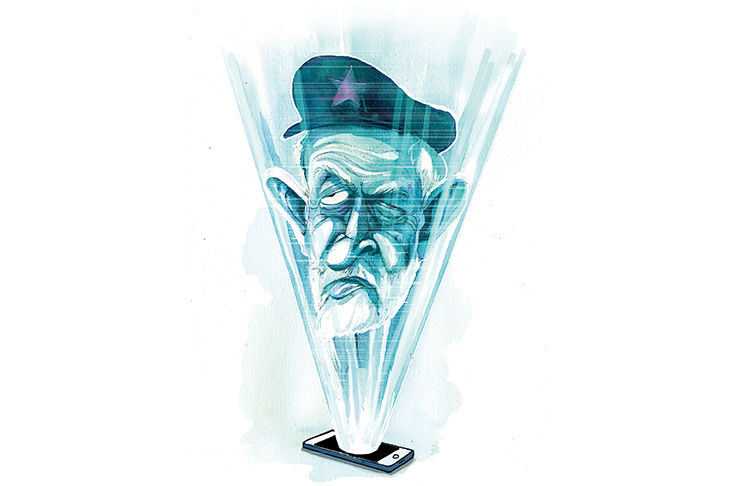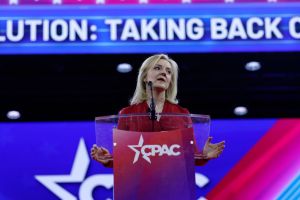You might well expect the final election debate, Johnson vs Corbyn head-to-head on primetime BBC, to provide the most watched moment of the election campaign. In fact, the clip on course to win that accolade has never even been aired on television, and if it were, some of its claims might fall well short of Ofcom broadcasting rules.
This video shows an actor called Rob Delaney, American star of the Channel 4 sitcom Catastrophe, promising to offer some home truths on the future of the National Health Service. He says that if the UK leaves the EU under Boris Johnson’s ‘disastrous’ Brexit deal, the NHS will be on the table: ‘Donald Trump is going to give it to Donald Trump Junior and Eric and Ivanka and they’re going to divvy it up and sell it to private pharmaceutical companies and the NHS as we know it will be gone.’ The way to stop this, he goes on to explain, is to vote Labour.
Although there is no evidence as of yet to suggest the US president’s daughter is champing at the bit to get her hands on the UK’s health service, that hasn’t stopped the video from going viral. In the new media landscape, this clip is as important as any debate moment.
If you doubt that, know that it has already reached 10 million views on social media, whereas a mere 6.7 million tuned in when ITV showed the first head-to-head debate between Corbyn and Johnson, and the Question Time leaders’ special had a peak audience of just 4.6 million. What’s more, a large chunk of those who shared Delaney’s Labour video on Facebook had never previously shared a Jeremy Corbyn post.
Digital platforms offer political parties a way to reach new voters. Yes, knocking on doors is still regarded as the most reliable way to get the vote out, but online campaigning — when done right — has the potential to change the political weather. Witness Vote Leave’s targeted adverts. In a cold winter election, a message that can be viewed inside on a laptop screen is especially important.
What this means is that there is a different conversation going on to the one you heard on the news — and all the rules have changed. One of the strangest moments of the campaign so far was a fake online story claiming Jo Swinson shot stones at squirrels — something she eventually had to deny. The online debate is hard to track, let alone regulate, and it’s rife with misinformation and vitriol.
In 2017, the Tories found themselves outgunned with their online output. They spent more than £2 million ($2.5 million) on Facebook advertising, but were stung by negative online stories that spread quickly. Theresa May’s personal endorsement of fox hunting was the single most viral topic of the campaign.
Meanwhile, Labour spent considerably less but managed to spread their message more widely thanks to a positive campaign that supporters wanted to share. That’s why Labour tend to be seen as the frontrunner when it comes to the digital battleground, and they are aided by a range of non-affiliated groups — described by some as satellites — that share memes and videos, the whole motley crew spearheaded by the pro-Corbyn grassroots group Momentum.
For this election the Conservatives are at pains to avoid a repeat of 2017. Their digital strategy has been revamped, and two young New Zealanders, Sean Topham and Ben Guerin, have been brought in to run the show. Their approach can’t exactly be described as conventional.
The team work on the mantra that a little bit of controversy can be helpful in getting your message shared. Or to put it another way, playing nice rarely gets you noticed. The Tories both made headlines and received widespread criticism for renaming the CCHQ press account as ‘factcheckUK’ during a TV debate. The party has also had an advert banned by Facebook that used clips of BBC presenters, including Laura Kuenssberg, quoting Tory election messages. The corporation complained the advert might mislead viewers into thinking its reporters were supporting the Tories.
None of this has CCHQ too downcast. There’s a general view that when it comes to online tactics, anything that gets people talking is a good thing. When Channel 4 refused to let Michael Gove stand in for Boris Johnson in its climate change debate, the Tories responded by sending him anyway along with a camera crew. That clip of Gove trying to get in was watched by 3.5 million people on Twitter, compared with the 850,000 who tuned in live for the full debate.
As the campaign enters its final stages, both main parties are keen to press their digital advantage. The Tories have a plan to spend much of their digital cost allowance in the final week of the campaign on targeted Facebook adverts. Labour have spent more so far. However, Google’s tracking of campaign spending suggests that the party is spending the most on constituencies where there is a Momentum-backed candidate rather than the closest fight.
For May and her team, it wasn’t until the election had been and gone that they realized how badly they had been losing the fight online. This time, there’s an acceptance on all sides that a digital offensive is the best form of defense. Despite this, no one seems quite sure where it will all lead.
This article was originally published in The Spectator’s UK magazine. Subscribe to the US edition here.



















